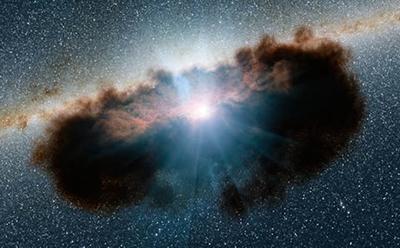Research finds cosmic clumpy donut around black hole

New research has revealed that the thick donut-shaped disks of gas and dust that surround most massive black holes in the universe are ‘clumpy’ rather than smooth as originally thought.
Until recently, telescopes weren't able to penetrate some of these donuts, also known as tori, which feed and nourish the growing black holes tucked inside.
The Monthly Notices of the Royal Astronomical Society study, which was co-authored by Dr Poshak Gandhi of the University of Southampton, described results from NASA’s Nuclear Spectroscopic Telescope Array (NuSTAR) and the European Space Agency’s XMM-Newton space observatory.
With its X-ray vision, NuSTAR recently peered inside one of the densest tori known around a supermassive black hole. This black hole lies at the centre of a well-studied spiral galaxy called NGC 1068, located 47 million light-years away in the Cetus constellation.
The observations revealed that the rotating material is not a simple, rounded donut but more like defective, lumpy donuts that a donut shop might throw away.
The new discovery is the first time that this clumpiness has been observed in an ultra-thick donut, and supports the idea that this phenomenon may be common. The research is important for understanding the growth and evolution of massive black holes and their host galaxies.
Donuts around supermassive black holes were first proposed in the mid-1980s to explain why some black holes are hidden behind gas and dust, while others are not. The idea is that the orientation of the donut relative to Earth affects the way we perceive a black hole and its intense radiation. If the donut is viewed edge-on, the black hole is blocked. If the donut is viewed face-on, the black hole and its surrounding, blazing materials can be detected. This idea is referred to as the unified model because it neatly joins together the different black hole types, based solely upon orientation.
“We don’t fully understand why some supermassive black holes are so heavily obscured, or why the surrounding material is clumpy,” said Dr Gandhi. “This is a subject of hot research.”
NGC 1068 is well known to astronomers as the first black hole to give birth to the unification idea. “But it is only with NuSTAR that we now have a direct glimpse of its black hole through such clouds, albeit fleeting, allowing a better test of the unification concept,” said Andrea Marinucci of the Roma Tre University in Italy and lead author of the study.
The team says that future research will address the question of what causes the unevenness in tori. It’s possible that a black hole generates turbulence as it chomps on nearby material. Or, the energy given off by young stars could also stir up turbulence, which would then percolate outward through the donut. Another possibility is that, the clumps may be from material that falls onto the donut from outside it. As galaxies form, material migrates toward the centre, where the density and gravity is greatest. The material tends to fall in clumps, almost like a falling stream of water condensing into droplets as it hits the ground.
“We’d like to figure out if the unevenness of the material is being generated from outside the donut, or within it,” said Professor Gandhi.
“These coordinated observations with NuSTAR and XMM-Newton show yet again the exciting science possible when these satellites work together,” said Daniel Stern, the project scientist for NuSTAR at NASA’s Jet Propulsion Laboratory in Pasadena, California.